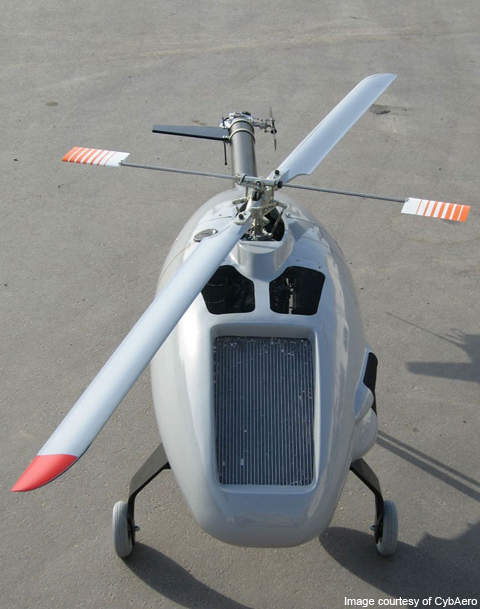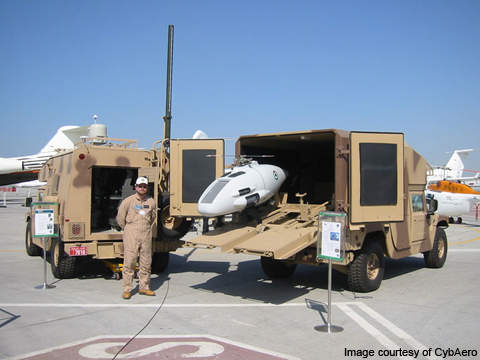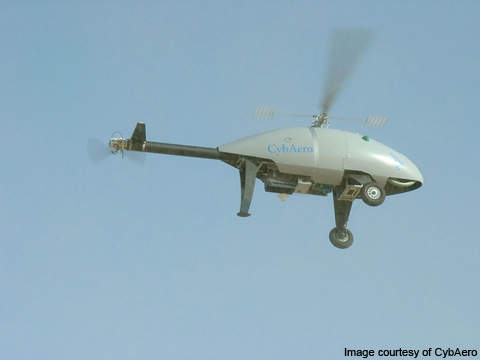The Apid 55 is a miniature vertical take-off and landing (VTOL) unmanned aerial vehicle (UAV) system designed and manufactured by CybAero (formerly known as Scandicraft Systems) for the United Arab Emirates Defence Agency (UAEDA). Each system incorporates three major components: Apid 55 aerial vehicle, a ground control station (GCS) and a payload control system.
The vehicle can perform intelligence, surveillance, target acquisition and reconnaissance operations in hostile environments even in adverse sight conditions. It captures the real time imagery or videos of the battlefield and transmits to the GCS through a satellite communication data link with in a range of up to 50km.
Flying at a maximum altitude of 3,000m, the UAV can provide its operators with real time intelligence data by executing surveillance and reconnaissance missions over a large area. The aircraft can be transported on a pick up transport vehicle.
An improved version, the Apid 60 was also built by CybAero. The Apid 60 can fly at a maximum speed of 110km/h. Its cruise speed is 90km/h. It can loiter in air for a maximum of three to six hours. The variant is fitted with a skid type landing gear.
Apid 55 UAV orders and deliveries
The UAEDA signed a €3.6m contract with CybAero in 2004 to acquire seven Apid 55 systems for border surveillance. The deliveries are yet to be completed.
Saab Aerosystems procured one Apid 55 system in 2005 to utilise as a base model for the development of Skeldar VTOL UAV. The company also obtained development rights from CybAero to build a derivative of Apid 55 for Swedish Armed Forces.
VTOL UAV design and features
Designed to suit both military and civil operations, the Apid 55 can take-off from and land vertically either on a runway or unprepared airstrips. The aircraft can execute wide range of civil operations including aerial photography, forest fire assessment, payload delivery, environmental monitoring, powerline inspection, search and rescue, chemical and biological hazard monitoring and day or night traffic surveillance.
The military applications encompass electronic warfare, mine detection, battle damage assessment, communication relay, riot control, ground troop escort, anti terrorism missions, border and coast patrolling and ordnance survey.
The aircraft features a robust airframe constructed with titanium, aluminium, glass and carbon fibre materials. It is fitted with a four-bladed main rotor system of 3.3m-diameter, two-bladed tail rotor system, alternators, antennas and back up power batteries.
A GPS, gyros, accelerometers, compass, infra-red altitude meter, barometric altitude, laser scanners and stabilised cameras are also installed in the helicopter.
Development
Development of the Apid 55 began in early 1990s. The maiden flight of the Apid 55 took place in January 2008 on the drill field in Stockholm, Sweden. The aircraft’s performance was examined in sub-arctic and desert environments.
Navigation
The Apid 55 can be controlled either manually from the GCS or through autonomous mode. The FCS-52 flight control system incorporated in the aircraft provides automated navigation and stabilisation.
The helicopter can be operated through pre-programmed waypoints, which can be changed during flight using a graphical user interface system. The ground station operator controls the vehicle with a joystick during semi-manual mode.
Sensors
The aircraft is equipped with electro-optic (EO) and infra-red (IR) sensors. The EO sensor transforms light rays into electronic signals for capturing real time imagery or videos of the battlefield.
Engines
The Apid 55 is powered by a single Hirith E18H engine which produces 41kW of output power using gasoline as fuel. The E18H is a two cylinder, two-stroke fuel injected engine designed and built by Hirith Engines. It is fitted with a drive shaft, drive belt and main gear box.
Ground control station (GCS)
The GCS is designed and manufactured by CybAero to process, retrieve, store and monitor the real time imagery or videos provided by the aircraft using a graphical user interface (GCU). The operators residing in the GCS operate the vehicle through payload control systems.
Performance
The Apid 55 can fly at a maximum speed of 90km/h. The cruise speed is 60km/h. The range and service ceiling are 50km and 3,000m respectively. The aircraft can loiter in air for a maximum of three to six hours.











